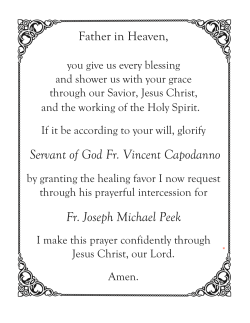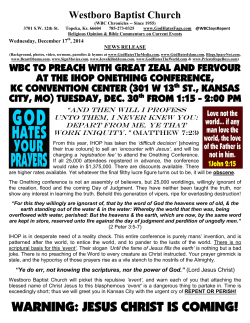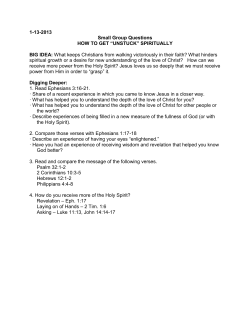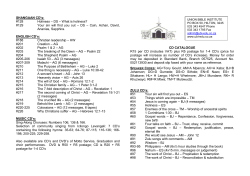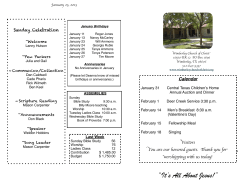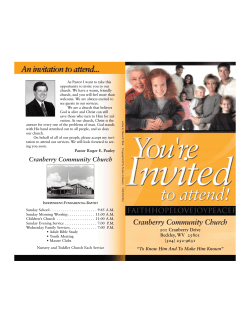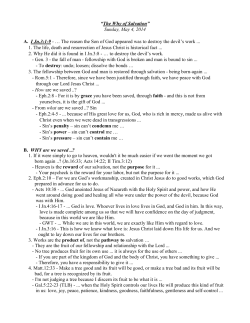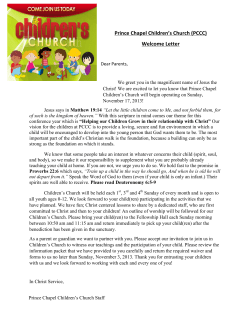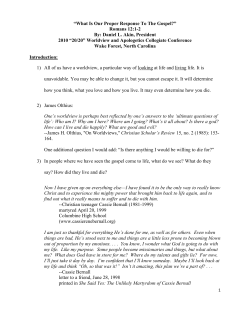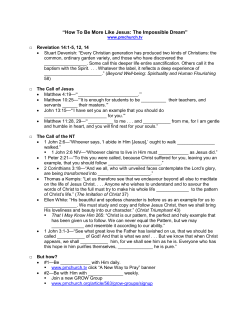
- Nurturing Faith
Adult Teaching Resources April 12, 2015 Season of Easter Of First Importance — 1 Corinthians 15:1-11 Walking in the Sunshine — 1 John 1:2-2:2 Children of God — 1 John 3:1-7 Real Love — 1 John 3:16-24 www.baptiststoday.org Subscribe to Baptists Today to access the core Bible content for this lesson. www.nurturingfaith.net Find links and videos related to this lesson. Nurturing Faith a 1 a April 12, 2015 Walking in the Sunshine 1 John 1:2-2:2 FIT Teaching Guide by Rick Jordan This adult teaching outline is designed to support The Bible Lesson by Tony Cartlege, printed in Baptists Today. You can subscribe to either the digital or print edition of Baptists Today to access the lessons. Please also ensure that each person in your class has a copy of Baptists Today so they can prepare before the lesson. Before the Lesson: Make copies of the handout for the Transformational Exercise. Fellowship Question Use one of the following to break the ice, to begin discussion, and lead into the study: What was the purpose of the last handwritten letter you wrote? We have many ways to say someone did “wrong.” In teams of 3-4, think up as many of these ways as you can and jot them down. Then, we will compare and compile our lists. Information The letters that we have in the New Testament were written because there were problems. If there was a perfect early Church, we would never know about it today, because Paul or Peter or John would have no cause to write. As it turns out, there were plenty of problems, so we have nineteen letters. First John is one of those letters. It is really more of a sermon than a letter in style, however, because it does not have a greeting or a signature. We aren’t even told who it is written by or to whom. Tradition and internal language and metaphor lead many to think that the author of the Gospel of John wrote it, so it has been attributed to John. Other scholars attribute it to a student of John’s, a leader in a “beloved community.” We will probably never have the answers to who wrote this or to whom, but we can tell that it is written to a Christian fellowship by a beloved leader of the early Church. Eugene Peterson makes these points about this book: “The community that received this pastoral letter was pretty much a mess. In addressing their behavior, Pastor John uses the words and phrases ‘lie’ or ‘liar’ five times, ‘hate’ four times, ‘child of the devil’ once and ‘commits sin’ once. He also makes references to failure or refusal to love, self-deceit, and refusal to help someone in need. Not an ideal congregation by a long shot. And yet not unusal.” [Scriptural references deleted, [Eugene H. Peterson. Christ Plays in Ten Thousand Places: A Conversation in Spiritual Theology. Grand Rapids: William B, Eerdmans. 2005. p. 311] Nurturing Faith a 2 a April 12, 2015 Information continued The book begins with a type of prologue that sounds very much like the prologue of the Gospel of John. [Have a class member read 1 John 1:1-4.] Why do you think the author insists that this is written by someone who has had a real, sensory, physical encounter with Jesus? (to give the author’s words credibility; to stress that Jesus did come “in the flesh”; etc.) The Bible Lesson writer notes: “The fellowship John has in mind is not a church dinner or social occasion. Koinonia comes from a root that means ‘common’ and in the New Testament describes the common bonds that Christians share as fellow children of God.” What are some of the “common bonds” we have with other Christians? (worship the same God; prayer; all under the Great Commission; baptism; Lord’s Supper, etc.) Although we have much in common, we have enough differences that we also have conflict in common! These could be minor differences or could be intense enough to lead to a split in the fellowship. Would you agree or disagree with this statement: In an ideal world, churches would never have conflict. [Have a class member read 1 John 1:5-2:2.] [If you used the second fellowship question, refer to the class members’ answers. If you did not, invite class members to suggest words that refer to someone doing something “wrong.”] Why do you think we skirt from using the word “sin” to refer to something we do that is morally wrong? We may think of “sin” as breaking rules that God established. But sin is deeper than that. “One of the major impediments to a life of love … is that a good many people in the community were denying that they sinned…It makes life much simpler. It means we don’t have to bother with relationships; it means we don’t have to take men or women seriously; and it means we don’t have to deal with God in a personal way — for sin is basically a depersonalizing word or act. It is not, in essence, breaking a rule, but breaking a relationship.” [Eugene H. Peterson. Christ Plays in Ten Thousand Places: A Conversation in Spiritual Theology. Grand Rapids: William B, Eerdmans. 2005. p. 316.] How does a denial of sin harm a relationship? If we focus on rules rather than relationship, what kind of religion do we nurture? (legalistic; perfectionistic; judgmental, etc.) How does that focus on rules affect relationships? How does a focus on rules affect our fellowship with God? Nurturing Faith a 3 a April 12, 2015 Information continued John talks a lot about light and darkness in this passage. We mentioned that the beginning of 1 John is similar to the beginning of the Gospel of John. Likewise, the prologue of John is similar to the first verses of the creation story in Genesis 1.Listen to these two passages. How do these passages about light relate to a life of love that 1 John promotes? [Have class members read John 1:1-5 and Genesis 1:1-5.] How do these passages about light relate to a life of love that 1 John promotes? First John 1:9 is a beautiful verse. It is the gospel in a sentence. How could you use this single verse to talk with a nonbeliever about your faith? Does anyone here have a story of how you have experienced this verse’s truth in your life? The Bible Lesson writer notes, “The word for ‘cleanses’ is in the present tense in Greek, which denotes continuous action. The constant grace and continuing forgiveness offered by Christ is good news, for even those who want to walk in the light continue to struggle with sin.” In this Easter season, it is good for us to reflect on what the life and death and resurrection of Jesus means. We have the benefit of 2000 years of time for reflection, interpretation and creating systematic theologies. We know that the disciples did not understand what Jesus was talking about prior to his death when he spoke of his resurrection. As time passed, as believers pondered and as some believers died before Jesus’ return, the early Church tried to make sense of what this meant. What was the purpose of Christ’s death? What is the meaning of Jesus’ resurrection? How do the ideas of Messiah, Savior and Redeemer fit with the experience believers had/have of Jesus? In verses 2:1-2, we have an early interpretation. How does 1 John 2:1-2 interpret the life and death and resurrection of Jesus? Transformational Exercise Your “soul work” homework for this week is to memorize and to meditate on 1 John 1:9. Use this card to help you to memorize the verse. Use the questions on it to guide your reflections. You might choose to take one of these questions each day this week as a journal prompt. [Close in a prayer something like this: Light of the world, dispel the darkness in our lives. Great Healer, heal our relationships. Teach us to love, as you love us and as you love the world. Amen.] Comments or Questions for Rick Jordan? You may send comments to the lesson plan author at rjordan@cbfnc.org. Rick is also available to lead workshops and conferences on Christian Education, with particular emphasis on how best to use the FIT Faith model. Nurturing Faith a 4 a April 12, 2015 Digging Deeper by Tony Cartlege Digging Deeper is designed to support The Bible Lesson by Tony Cartlege, printed in Baptists Today. Watch for the “shovel” icon in the The Bible Lesson, and then reference that item in this Digging Deeper resource. You can subscribe to either the digital or print edition of Baptists Today to access the lessons. Please also ensure that each person in your class has a copy of Baptists Today so they can prepare before the lesson. Learning from 1 John — Today’s lesson is the first of six from the short but significant book known as 1 John. The book is popular with beginning Greek students because the language is straightforward and easy to read. It is popular with many other readers because of its strong emphasis on love. As we study texts from the book during the postEaster season, we’ll discover many reasons to consider 1 John a favorite. Who wrote 1 John? — Readers typically assume that 1 John was written by John the son of Zebedee, a disciple of Jesus, but the author does not claim that identity. There is no “I, John, say to you …” or “As the disciple whom Jesus loved, I saw with my own eyes …” This might be expected, because 1 John lacks many attributes of a typical letter. Like Hebrews, it seems to be more of an exhortation or pastoral sermon that was written for general circulation among the churches, especially those who faced the problem of false teaching addressed in the homily. The author of 2 and 3 John, which are clearly written as letters, identifies himself only as “the elder” (ho presbuteros). There was a tradition of an elder named John, but some lack of agreement in the early church as to whether the apostle John and the elder John were the same person. There is strong internal evidence to consider. The vocabulary, syntax, and style of 1 John are remarkably similar to that of the Gospel of John. Both refer to Christ as “the Word,” for example. The description of the Spirit as an advocate or “paraclete” (parakletos, meaning “one called along side”) appears only in the Gospel of John (14:16, 26; 15:26; 16:7), and in 1 John (2:1). Likewise, the term monogenes (usually translated “only begotten” or “unique”) appears as a description of Jesus’ relation to the Father only in John (1:14, 18; 3:16, 18) and in 1 John (4:9). Both the Gospel of John and 1 John are also fond of polarities such as light and darkness, life and death, love and hate. Both consider love to be Christ’s key command. There are some differences, but many similarities. What other evidence do we have? The author of 1 John claims to be an eyewitness of what Jesus said and did (1 John 1:1-3), he speaks with a certain authority that some would attribute only to an apostle, and his frequent references to readers as “children” (1 John 2:1, 28; 3:7; 2 John 1; 3 John 1) suggest that he is an older man writing to a younger audience. Some writings from the early church fathers attributed both the Gospel of John and 1 John to John the apostle, while assigning 2-3 John and Revelation to “John the Elder,” whom they considered to be a different person. Nurturing Faith a 5 a April 12, 2015 Digging Deeper continued Many modern scholars believe that some or all of the “Johanine” works were written by a second-generation believer who was closely associated with the apostle, or a careful student of his other writings, so that his own vocabulary, style, and theology echoed that of his mentor. Some question whether the Gnostic ideas confronted by the books had developed fully prior to John’s death, probably near the end of the first century. Others would counter that the presence of Gnosticism, at least in an incipient form, is also suggested in some of Paul’s writings. Ultimately, we cannot say for certain whether John the Apostle wrote the letter we now call 1 John, but there is no convincing reason to deny that the letter could echo the thinking of the son of Zebedee. For purposes of simplicity, we’ll use “John,” “the writer,” or “the author” interchangeably. Issues of location and date are bound up with authorship. There is a strong tradition that the Apostle John lived and ministered in and about Ephesus, the home of an important church in Asia Minor. Writing in Against Heresies (3.3.4) in about 180 CE, Irenaeus cited a tradition that John was living in Ephesus when he wrote the Fourth Gospel, and remained there until the time of Trajan. Since Trajan’s rule did not begin until 98 CE, this would have made John a very old man for his day. If John indeed was the author, 1 John would probably have been written from Ephesus as well, sometime in the last two decades of the first century. Those who prefer to think of the author as coming from a Johannine community tend to date the works a decade or two later, assuming more time would have been needed for the Gnostic ideas opposed in the letters to have spread. Why was 1 John written? — The author appears to have been writing to counteract certain heresies that had arisen, as well as to reassure his readers that the gospel they had believed is sure. In 1 John we find at least four purpose statements, not counting those in 2:12-14: “We are writing these things so that our joy may be complete.” (1:4) “I am writing you these things so that you may not sin.” (2:1) “I have written these things to you about those who are trying to deceive you.” (2:26) “I have written these things to you who believe in the name of the Son of God, so that you may know that you have eternal life.” (5:13) The last of these bears a remarkable similarity to the concluding purpose statement of the Gospel of John: “But these are written so that you may believe Jesus is the Messiah, the Son of God, and by believing you may have life in His name” (John 20:31). Note the difference in perspective: The gospel was written as a witness “so that you may believe” (or “come to believe,” NRSV). 1 John was written to people who already believe, but appear to need assurance “that you may know that you have eternal life.” Nurturing Faith a 6 a April 12, 2015 Digging Deeper continued The book, then, is written as a persuasive sermon or homily designed to highlight errors found in the false teaching that plagued the churches and had led to some defections (2:18-19), while encouraging the members toward right believing and right living. The document does not follow a clearly defined sequence of thought, however. Although some scholars find intricate structures, there is a sense in which it appears the author sat down and wrote (or dictated) his thoughts in a rather “stream of consciousness” fashion. Thus, there is overlapping of thought and considerable repetition, rather than a clearly defined structure. Most commentators tend to divide 1 John into either three or seven sections, but the sections they find are not always the same. Most agree that there is a prologue (1:1-4) and an epilogue (5:13-21) that sandwich a series of overlapping calls for believers to understand the light and truth that come from accepting God’s teaching, and to live obediently with the love and discernment that comes from being children of God. Drawing lines and deciding where the argument shifts from one to another is largely a matter of subjective judgment: the fact that so many scholars see the document falling into so many different divisions is sufficient testimony to the difficulties. I would suggest a seven-part structure within the bookends provided by the prologue and epilogue. This way of looking at the text is not perfect, but it provides one way of seeing how the author approaches his central themes from different angles designed to achieve the same purpose. Prologue: true knowledge, true joy (1:1-4) I. Walk in light (1:5-2:6) II. Walk in love (2:7-17) III. Walk in truth (2:18-29) IV. Walk as God’s children (3:1-24) V. Walk with discernment (4:1-6) VI. Walk in God’s love (4:7-21) VII. Walk with confidence (5:1-12) Epilogue: true knowledge, true life (5:13-21) I have used the imperative “walk” as a catch-term to reflect the writer’s instructive way of giving advice, and his characteristic use of “walking” as a metaphor for living. I arranged the outline in staggered fashion to illustrate a general chiastic structure of the book. The author begins and ends with the contention that he (as opposed to false teachers) is teaching true knowledge that leads to joy and life. Nurturing Faith a 7 a April 12, 2015 Digging Deeper continued The writer’s call to walk in the light that comes from God (1:5-2:6) is balanced toward the end by a call to live in confidence by accepting the previous teachings (5:1-12). John’s emphasis on obeying Christ’s command to love one another — a theme shared with the Fourth Gospel, is emphasized in 2:7-17, and again in 4:7-21, where abiding in God is equivalent to abiding in love. While groups such as the Gnostics claimed to have new or secret knowledge that went beyond the gospel, John instructed his readers to believe the truth they have already been taught (2:18-27) and to test any spirit of temptation in the light of that truth (4:1-6). These matching emphases surround 2:28-3:23, which sets forth the heart of the issue: Believers should get serious about Jesus and live as the children of God who walk in light and love because they understand the truth. What is Gnosticism? — At one time it was common to identify John’s opponents with a movement called Gnosticism. Current commentators are less confident that Gnosticism had developed in an organized fashion by the time John wrote, or that it constituted a particular threat. Some of the issues John dealt with, however, are consistent with conflict that could have arisen from teachings similar to those developed by the Gnostics, so it may be worthwhile to consider their beliefs. Gnosticism was not a monolithic belief system, but took a variety of forms. “Gnostic” comes from the Greek word “gnosis,” the root of the English word “knowledge.” The Christianized version was one of several variations on an underlying theme. Gnostic teachings were appealing to some early church members because they claimed to have secret knowledge not known to others in the church. In general, Gnostics believed in the existence of a high and holy “Spirit God” who created all things in a series of “emanations,” or levels of creation. Each descending level of creation, while maintaining aspects of divinity, was one step further removed from the pure “Spirit God.” In the Gnostic view, the God of the Old Testament was not the “Spirit God,” but the lowest emanation of divinity (sometimes called the “demi-urge”), which created the world. Each person on earth (the very bottom of the created order) was thought to have a “divine spark” within, held captive by both the body and soul. For salvation, that spark had to be awakened by secret knowledge in order to make its way through the various spheres of divinity, making progress toward the “Spirit God.” Christian Gnostics taught that Christ came directly from the Spirit God, bypassing the other emanations, in order to bring the secret knowledge that followers needed to set free their divine spark and make upward progress toward the god who was pure spirit. Thus, they distinguished between the human Jesus and the spiritual Christ who inspired him, in essence denying both. Some thought there was no human man named Jesus, only the Spirit Christ in the appearance of a man. These are called “Docetic Gnostics,” because they taught that Jesus only seemed human (Greek dokeo means “appear” or “seem”). Nurturing Faith a 8 a April 12, 2015 Digging Deeper continued In Gnostic thought, the spirit was inherently good, and all things material were inherently evil. Thus, some taught that one’s physical behavior was of no consequence, since the only thing that really mattered was the spiritual. This, of course, is at odds with Christian teaching in which one’s spiritual and physical lives are intimately connected, and sin matters very much. The author of 1 John wrote to combat the theology behind this teaching, along with its related moral and social implications. Much of what we know about Gnosticism comes from the Nag Hammadi library, a collection of 13 ancient codices discovered in northern Egypt in 1945 (a codex is bound in book form, rather than rolled as a scroll). These included several Gnostic works including some purporting to be gospels: the Gospel of Thomas, the Gospel of Philip, and the Gospel of Truth. It is the writings of this sect that spawned conspiracy theories such as those behind the popular book and movie, The Da Vinci Code, as well as the recently rediscovered and highly publicized Gospel of Judas. Scholars have known of the existence of the Gospel of Judas for years, but did not have access to the text until the Coptic document surfaced on the antiquities market and was ultimately obtained and published by the National Geographic Society. About 180 CE, in Against Heresies (1.31.1), Irenaeus of Lyons spoke of the document. He wrote: “They [a group of Gnostics called the Cainites] declare that Judas the traitor was thoroughly acquainted with these things, and that he alone, knowing the truth as no others did, accomplished the mystery of the betrayal; by him all things, both earthly and heavenly, were thus thrown into confusion. They produce a fictitious history of this kind, which they style the Gospel of Judas” (Ante-Nicene Fathers, vol. 1, p. 358). Gnostics tended to find their heroes in the anti-heroes of the Bible, people such as Cain, Mary Magdalene, and Judas. The teachings of Gnosticism denied the deity of Jesus, the essence of the atonement, the importance of moral behavior, and the need to love others. In short, they denied the gospel, but their secretive teaching and loose approach to sin appealed to many. “What” or “who”? — Readers may wonder why the author began with the neuter form “What was” or “That which was” rather than “The One who was” or something similar. Perhaps John used the more abstract term because he was discussing Christ both as a person and as the “Word of life.” It is also possible that he intentionally began with the more abstract term to emphasize the effect of moving toward a more personal description of his encounter with Christ. “Our” or “your”? — Readers often wonder why John says “our joy may be full” instead of “your joy” (v. 4). In fact, a majority of ancient Greek manuscripts have the word “your” instead of “our.” The oldest and best manuscripts, however, have the more difficult reading “our,” which someone changed to “your” because he thought it made better sense, and the change was passed down in future copies. Nurturing Faith a 9 a April 12, 2015 The Hardest Question by Tony Cartlege The Hardest Question is designed to support The Bible Lesson by Tony Cartlege, printed in Baptists Today. You can subscribe to either the digital or print edition of Baptists Today to access the lessons. Please also ensure that each person in your class has a copy of Baptists Today so they can prepare before the lesson. How should we understand the phrase “atoning sacrifice”? No one can claim to fully understand the atonement — just how it is that Christ’s work makes possible the forgiveness of our sins. In 1 John 2:2, the pertinent Greek word is hilasmos. It is variously translated as “propitiation” (KJV, NASB95, HCSB), “expiation” (RSV), and “atoning sacrifice” (NIV11, NRSV, NET). The word appears only here and in 1 John 4:10 in the New Testament. In the Greek translation of the Old Testament, it translates the word kippurim, which means “a covering.” One’s translation preference is generally flavored by his or her understanding of the atonement. The translation “propitiation” suggests the penal substitutionary view of atonement, in which Jesus’ death is seen as a blood sacrifice given to appease God’s wrath over human sin. The penal substitution view, like the ransom view, the example view and others, reflects an attempt to understand how Christ’s atonement became effective. The penal substitution view, while not universal, is traditionally the most common view among Baptists, partly because it seems easiest to understand. The major problem with the substitutionary approach is that it appears to divide God against God. It portrays God the Father as hostile and angry over human sins and in need of appeasement, while God the Son sheds his blood to satisfy the Father’s wrath. Many find this to be an inadequate view of God, who is both gracious and consistent. Whatever Christ did, God did. Paul described it by saying “in Christ God was reconciling the world to himself, not counting their trespasses against them …” (2 Cor. 5:19). John’s approach to the atonement focuses more on God’s offer of reconciliation and relationship. If there is hostility in the equation, it is on the part of humanity, not God. John’s use of the term hilasmon points to a “covering” of our sin without necessarily requiring a penal substitution. In this view, Christ’s death “covers” our sin and opens the door for us to enter fellowship with God. Thus, Christ as our advocate facilitates our union with God through forgiving our sins and reconciling us to God. The translation “expiation” seems to convey this view. Translations that render the term as “atoning sacrifice” take a middle road, pointing to Christ’s reconciling work without appearing to make a judgment about how that reconciliation was effected. More important than the specific means by which Christ atoned for our sins is John’s insistence that Christ’s work is intended for and available to all people. Some readers find support in this verse for a belief that God will ultimately save all people, though other verses in 1 John appear to contradict a universalistic view (3:14-15; 5:12, 16). Nurturing Faith a 10 a April 12, 2015 The Hardest Question continued John’s claim in 1 John 2:2 offers a powerful argument against the Calvinistic tenet that God alone has chosen who will be saved, and that Christ’s death is effective only for them. The plain meaning of the verse is that Christ died not only for our sins, “but also for the sins of the whole world.” In the mid-19th century, Baptists were bitterly divided between “Particular Baptists” who believed Christ died only for the particular people chosen as the elect, and “General Baptists” who believed in a general atonement, intended for everyone who believed. John believed that Christ’s atonement was sufficient to cover the sins “of the whole world,” and that those who truly trust in Christ and thus experience forgiveness of sin and fellowship with God will demonstrate such a change of life in the way they live — walking in the light. Nurturing Faith a 11 a April 12, 2015 If we confess our sins, he who is faithful and just will forgive us our sins and cleanse us from all unrighteousness. 1 John 1:9 (NRSV) What does it mean to confess? Since sin has more to do with relationships than rules, what do I need to confess to God about my role in broken relationships? How is God faithful to me? How is God just? What gifts come with God’s forgiveness? What in my life needs cleansing? How does it feel to be cleansed of unrighteousness? How does the truth of this verse affect my relationship with God? How does the truth of this verse affect my relationship with my neighbors? Nurturing Faith a 12 a April 12, 2015
© Copyright 2025
